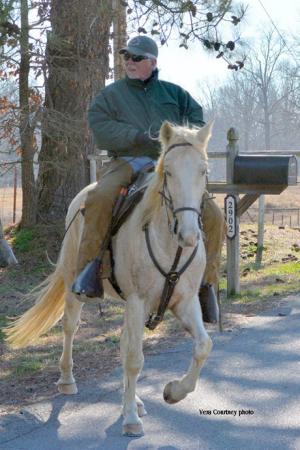By Tommy Brannon
Field Trialing is one of the few outdoor horse riding sports that takes place throughout the fall and winter in the mid-south. December, January and February see field trailing in full swing, with field trials taking place every week. The culmination of a successful field trial season for bird dogs is the National Championship at Ames Plantation in Grand Junction, Tennessee. This is the 117th year for the National Championship and the 101st year to be held on Ames Plantation.
This year’s competition will begin on February 8 and should last approximately two weeks, depending on the weather and the number of dogs competing. There are both morning and afternoon braces, Monday through Saturday. Two dogs compete in each brace and the only real way to see the action is from horseback.
These field trails are open to the public, but riders must abide by the rules of the field trial and Ames Plantation. Riders stay in a group (Gallery) so as to not interfere with the dogs’ work. For safety, it is important to be mounted on a horse that does not kick and is completely biddable. No alcohol is allowed, nor stallions. Field trialing is a family friendly sport, so children can enjoy the day. One of this year’s competition days is scheduled for President’s Day, February 15, when many children are out of school.
The bird dogs that qualify for the National Championship must have won two first placements in one of nearly 100 field trials held across North America. Once that qualification is met, a returning dog must place in one of the trials to re-qualify for the current year’s National Championship. The 2015 National Champion, Miller’s Dialing In, is returning for this year’s competition, as are other dogs from past championships.
The judges for this year’s competition are: Doug Vaughn of Saskatoon, Saskatchewan, Charles F. Bryan of Moscow, Tennessee, and Dr. Rick Carlisle, director of Ames Plantation, Grand Junction, Tennessee. The National Champion is the dog who best meets the “Amesian Standard,” developed by Hobart Ames (1865-1945), who owned the Ames Plantation 1901-1945 and was President of the National Championship organization for 43 years.
The structure of field trails has similarities to some other horseback field sports. The dog is trained and controlled by a handler and assisted by a scout. Both competing dogs are released simultaneously at the beginning of the brace, called the breakaway. The handler and the dogs’ owners usually ride near the judges. The scout may be asked to range out to find the dog for the handler if contact with the dog is lost. This may happen when a dog has found quail and is “on point.” The Gallery of mounted spectators follows behind and is monitored and controlled by the Marshalls. All Gallery riders have to keep quiet and stay together behind the judges.
It is fascinating to listen to the Handler communicate with his dog – calling and whistling – and to watch an enthusiastic dog respond to the calls. The dog needs to stay ahead of the riders and work the course.
It is amazing how a great pointer or setter can smell a quail in the thickest of underbrush! The sense of smell is all they have to detect these little birds that normally move in coveys seeking the food they need to survive. The dog will maintain the point until the handler dismounts, finds the covey, flushes it, and fires his/her blank pistol. Then all move off to find another covey.
An unproductive (UP) is when the birds flush before the scout or handler arrives at the point. This will count against the dog, but does not disqualify him/her. Too many Ups, however, may cause the dog to be “picked up,” whereupon the dog is taken out of the competition.
Another action that may cause a dog to be picked up is for the dog to not honor a brace mate’s point, either by not “backing” (i.e. staying back and letting the other dog stay on point) or rushing in and steeling the point. Just like humans, bird dogs need to play fair.
The most popular horses at field trails are gaited horses, such as Tennessee Walking Horses, Paso Finos, Saddlebreds, and Missouri Fox Trotters. Occasionally, one will find Quarter Horses, pleasure horses, and ponies. This is the kind of riding that even tempered Tennessee Walking Horses were bred for, sure footed riding for hours in open fields, mud, and woods in all kinds of weather conditions. If you love horses and dogs field trialing is great fun.














